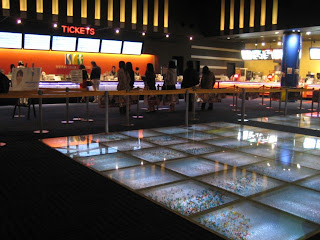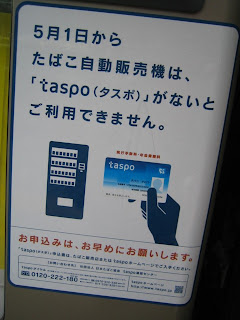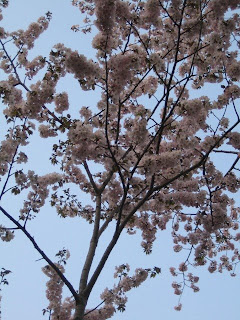
All work and no play would make for a very dull Belated Birthday Girl, and of course that was never going to happen, so amongst the onsen trips and other sightseeing, I've been a frequent visitor to a couple of Sapporo's multiplex cinemas (I feel slightly ashamed that I've not investigated any smaller, arthouse ones, but the multiplexes are very convenient, and there's generally been something on at one or other of them with enough interest for me). Besides, as long as I make sure that plenty of the films I go to see are Japanese, I can legitimately think of it as part of the study trip. So here's a round up with short reviews of the Japanese films I've seen so far (plus one non-Japanese, but I feel justified including it, as you'll see).
Ashita e no Yuigon - 明日への遺言
The story of a war crimes trial of a World War II Japanese General who ordered the executions of some captured US airmen, I thought this might be a serious and interesting film. However, it turned out to be quite bad in many ways. The basis of the General's defence was that that the airmen were in fact executed for war crimes themselves (because indiscriminate aerial bombardment was against the laws of war). This might well be a historically accurate account of the defence, but made this a far less interesting film than one which had actually been addressing in a thoughtful way war crimes by Japanese from a Japanese perspective. But as well as the subject being less interesting than I had hoped for, there were many flaws in the script, acting and direction. The dialogue delivery (in English: about half the film was in English) of the American characters was laborious; the Japanese general was depicted as a man of integrity who won the admiration of all sides, taken so far as to strain credulity; and the use of sentimental music whenever the accuseds' family members were involved was particularly cheesy.
Kurosagi: the Movie - 映画クロサギ
I believe Kurosagi started out as a manga, and then a TV series was made, and then this movie. As such, it was the first of the Japanese films I've seen here which was an adaptation/spin-off, but not the last, as you'll see below. Kurosagi is a con-man, who cons other con-men, out of some desire for revenge for the deaths of his family members due to an earlier con. Or something. The film was quite fun, and stylish, the acting decent, and I remember that I enjoyed it well enough. But it was sometimes difficult for me to follow (just down to the limits of my Japanese, I'm sure!), and I was a bit shaky about quite a lot of the details, and to be honest not much has stuck in the memory. Maybe one to revisit if a cheap Hong-Kong subtitled DVD ever comes along.
Mongol - モンゴル (international site here)
This is my slight cheat. Mongol is not a Japanese film, although the lead character is played by a Japanese actor. The dialogue is, in fact, in Mongolian (with tiny amounts of Chinese). But as I don't speak Mongolian, my experience of this film was through the Japanese subtitles, so I feel justified in including it here. Anyway. Mongol is the story of Ghengis Khan's early years, with Asano Tadanobu as Temudjin (as he was known before he became known as Genghis Khan). It is a very episodic movie, starting in Temudjin's childhood, and going on to show key events which made Temudjin into (or showed the ways he was becoming) the great Mongol warrior and leader we all know and love. The landscapes and scenery where it was shot (Khazakstan, China and Russia) are absolutely stunning, and there are some decent battles, although shot in the slightly cranked style which seems fashionable these days. Asano is fine as Tamudjin, but the film is stolen completely by Honglei Sun as Jamukha whenever he is on screen (he deservedly won Best Supporting Actor at the Asian Film Awards for his performance). The use of voiceover and sparing, measured dialogue, meant I could actually follow the subtitles pretty well. I felt the dialogue was occasionally somewhat didactic in telling us how "different" Tamudjin was to other Mongols, but it might come across differently if you can understand all the subtitles. Anyway, it is gorgeous to look at, and definitely worth seeing: this one does actually have a wide international release.
Sushi Prince Goes to New York - 銀幕版 スシ王子!ニューヨークへ行く
Another spin-off, of the TV series “Sushi Prince” スシ王子. The story of how the Sushi Prince, erm, goes to New York, and there saves sushi from evil corrupting forces, in spite of a morbid fear of fish eyes, this looked fun from the trailer. Sadly, it was a bit of a disappointment, being nowhere near as funny as I'd hoped. I know that comedy is one of the most difficult things to get in a language you are not fluent in, but there was quite a bit of dialogue in English, and that was all painfully unfunny, too, so I don't think it's just me not getting it. And as you'll see from the next film, I don't always have that trouble. Also, it looked from the trailer that it would be a good mix of comedy and action, but as well as the comedy not being funny, it was very light on the action, and what there was, was also pretty poor. So sadly, this one failed to meet my expectations.
Shaolin Girl - 少林少女
In complete contrast to Sushi Prince, Shaolin Girl was very good fun indeed, and easily lived up to its trailer. Exec produced by Stephen Chow, and with a couple of Stephen Chow/Wong Jing regulars in the supporting cast, this is a kind-of official Japanese member of the Shaolin Soccer family. And directed by Katsuyuki Motohiro, who has made several other films which I own on DVD and have enjoyed (Space Travelers, Bayside Shakedown I & II, Udon). Not as much silliness as I remember from Shaolin Soccer et al, although some of what silliness there was was provided by the Stephen Chow/Wong Jing alums, but very funny, and with seriously good action sequences. It was kind-of "Shaolin Lacrosse" with evil men in suits, with a Kill Bill-meets-Game of Death-inspired finale. Although I could make some specific criticisms, I won't as they'd be Spoilerific (I certainly hope there's a subtitled DVD, if not an international release, so I hope people reading this outside Japan will have a chance to see it for themselves), but also because they are minor gripes in something as fun as this was. Mongol may have been an objectively better film, but this was certainly the one I'd enjoyed most (although there have since been a couple almost able to rival it).
Partners: the Movie - 相棒ー劇場版
Another spin-off from a TV series (Aibou ("Partners") - 相棒). This was a well enough made and entertaining cop action thriller, but the Japanese was a lot harder to understand than most of the other films I've seen, and so I missed a lot of the details, and in this sort of film, the details matter. The basic story was about someone systematically killing people of a death list which they put on a web site, and involved a lot of cat and mouse police work, and a fair bit of running around the streets of Tokyo (and not just by the runners in the road race which was being targeted). And chess. Anyway, it looks like I may get the chance to see what I missed, if I decide I want to.
The Last Princess - 隠し砦の三悪人
The first remake of the films I've seen (but not the last – are you seeing a pattern here...?). This is a remake of Kurosawa's classic The Hidden Fortress: the Japanese title of both films is the same, but they have chosen to highlight different aspects in the international titles. It was very good fun. Although there was a lot of Japanese I couldn't understand, there was more than enough that I could to make it worthwhile, and also the overall story was easy enough to follow. If you've seen Hidden Fortress (or, for that matter, Star Wars) you'll be familiar with the basics, where a princess and general cross the empire with the help of a couple of yokels. There was plenty of humour and excitement, and plenty of decent action in it, too. I must go back some time to see Hidden Fortress again, to work out how much came directly from that, and how much came by way of Star Wars: definitely more than a touch of Darth Vader about the main baddie in this version! If they have chosen to borrow back from Star Wars, too, personally I think that's quite neat. Also nice to note that they kept in fancy scene transitions as an homage to both. Japanese cinema releases often have a nice shiny picture pamphlet for the film on sale, and I enjoyed this one enough to buy the pamphlet, and picked up the one for Shaolin Girl while I was at it.
After School - アフタースクール
Kenji Uchida's After School was another very good film, although I had completely misunderstood the sort of film it was from the trailer - and it was all the better for it. I'd somehow decided it was some sort of TV spin-off about old school friends and relationships, but not only was it one of the very few completely original screenplays I've seen so far – Uchida's first since he won a writer's award in 2005 at Cannes with his previous film, Unmei ja nai Hito ("A Stranger of Mine") - the story was nothing like I'd imagined, involving (amongst other things) detectives, yakuza, and corruption. A private detective is hired to try to find missing businessman Kimura (whose heavily pregnant wife gives birth the day he goes missing) and ends up hooking up with a schoolteacher friend of Kimura's to try to find him. The search soon leads to the discovery of yakuza connections - and the detective has yakuza problems of his own... I know there are plenty of details I missed, but it's a very clever – and often very funny - film, and I caught enough of the dialogue to get what was going on and enjoy it a great deal. I have no idea if there is any possibility of an international release, or even a subtitled DVD, but if the chance comes to see this, I would certainly recommend it. And I think you'll enjoy it more if you don't find out too much more about it in advance, either.
Yama no Anata – Tokuichi no Koi – 山のあなた - 徳市の恋
Another remake, this time of an even older film than Hidden Fortress. Yama no Anata is a remake of the 1938 film Anma to Onna (“The Masseurs and a Woman”). The story of some blind masseurs, and in particular one named Toku (aside: I have just realised that all the masseurs in the film had the “surname” of Ichi: just like a more famous cinematic blind masseur I can think of), who spend half the year at a hot spring resort by the sea, and half at a mountain one. The film takes place one year at the mountain resort, when a woman from Tokyo comes to stay, and shows the effect she was on those around her, especially Toku. Nicely shot and good use of sound design, gentle and very old-fashioned: I suspect it is a very straight remake, so much that you wonder why they bothered, to some extent (although I've not seen the original, but this felt like it could have been made 70 years ago). One interesting fact I'd missed, but which Spank the Monkey pointed out to me. This is not the first film by this director which I've seen: in 1998, Ishii Katsuhito wrote and directed his first film, the rather fun manga adaptation Samehada Otoko to Momojiri Onna (“Shark Skin Man, Peach Hip Girl”), starring Asano Tadanobu. Well, to call this a change of pace would be an understatement (although he's done a few other things in the intervening years, so I can't say whether either is typical of his work or not, or whether he's just a very varied director). Anyway, call me shallow, but that was more my sort of thing.
So, from what I've been seeing, it would seem that the current state of Japanese cinema is mostly spin-offs and remakes (although this might be an unfair assessment: I've only been seeing a subset of what's been on release, after all), but some of those have been pretty darned good, so I don't want that to sound dismissive. I have at least three other films already or soon to be on release which I intend to watch before I'm done (none of which I believe are remakes or spin-offs, although one is an adaptation), so keep watching the blog for probably one more filmy update, if you're interested. And if anyone wishes to comment on any of these, or other current or recent Japanese releases, feel free (though please: absolutely no Spoilers!).













































